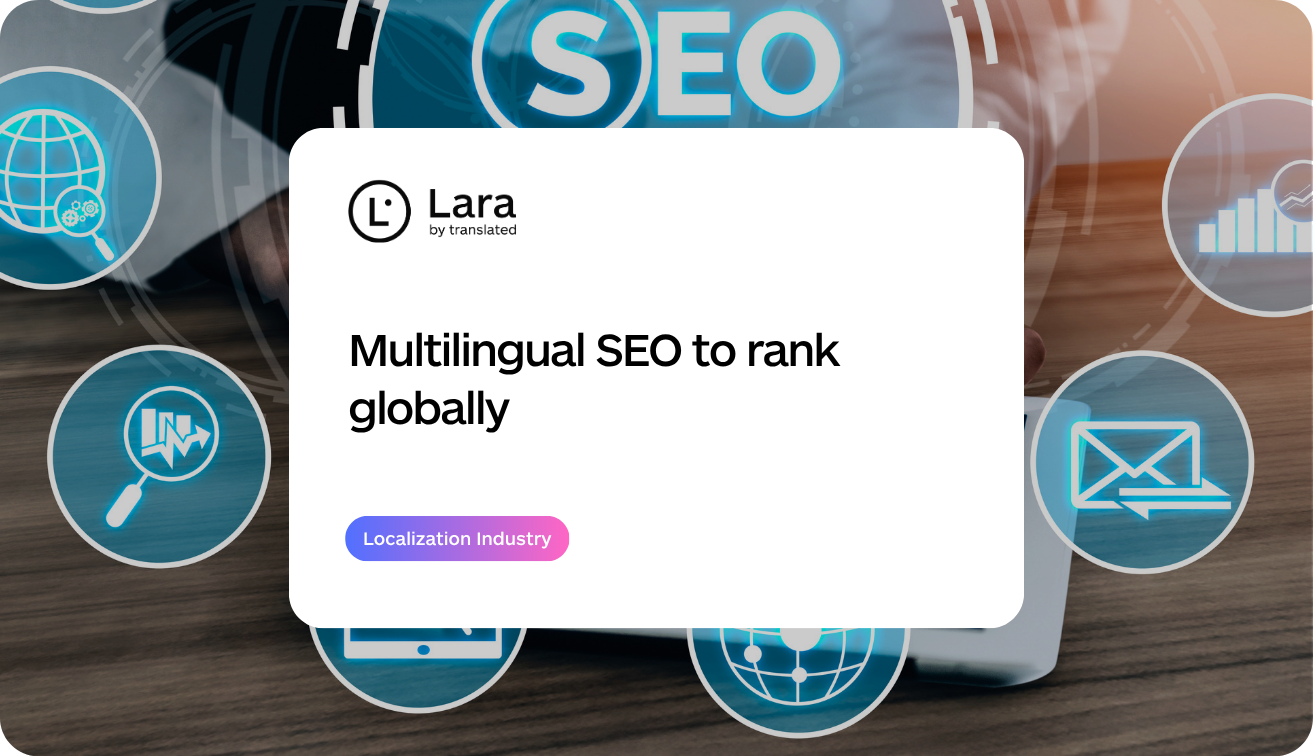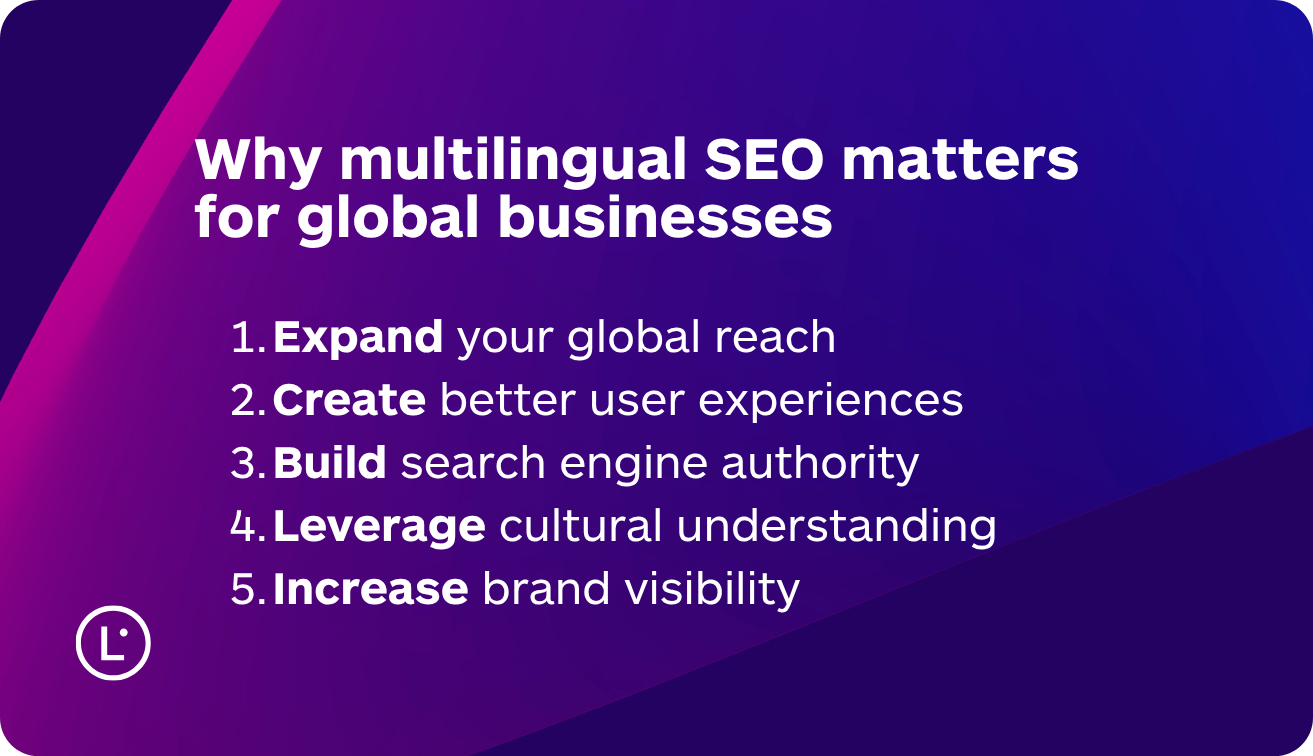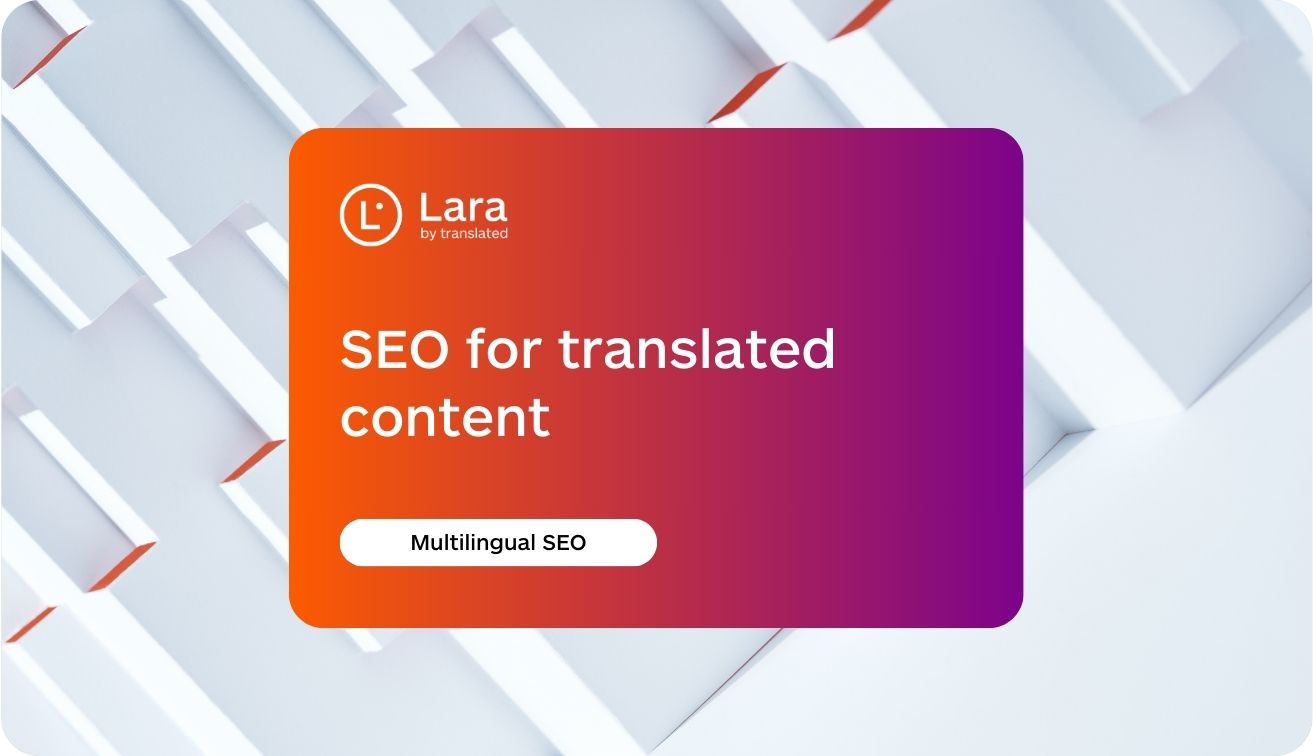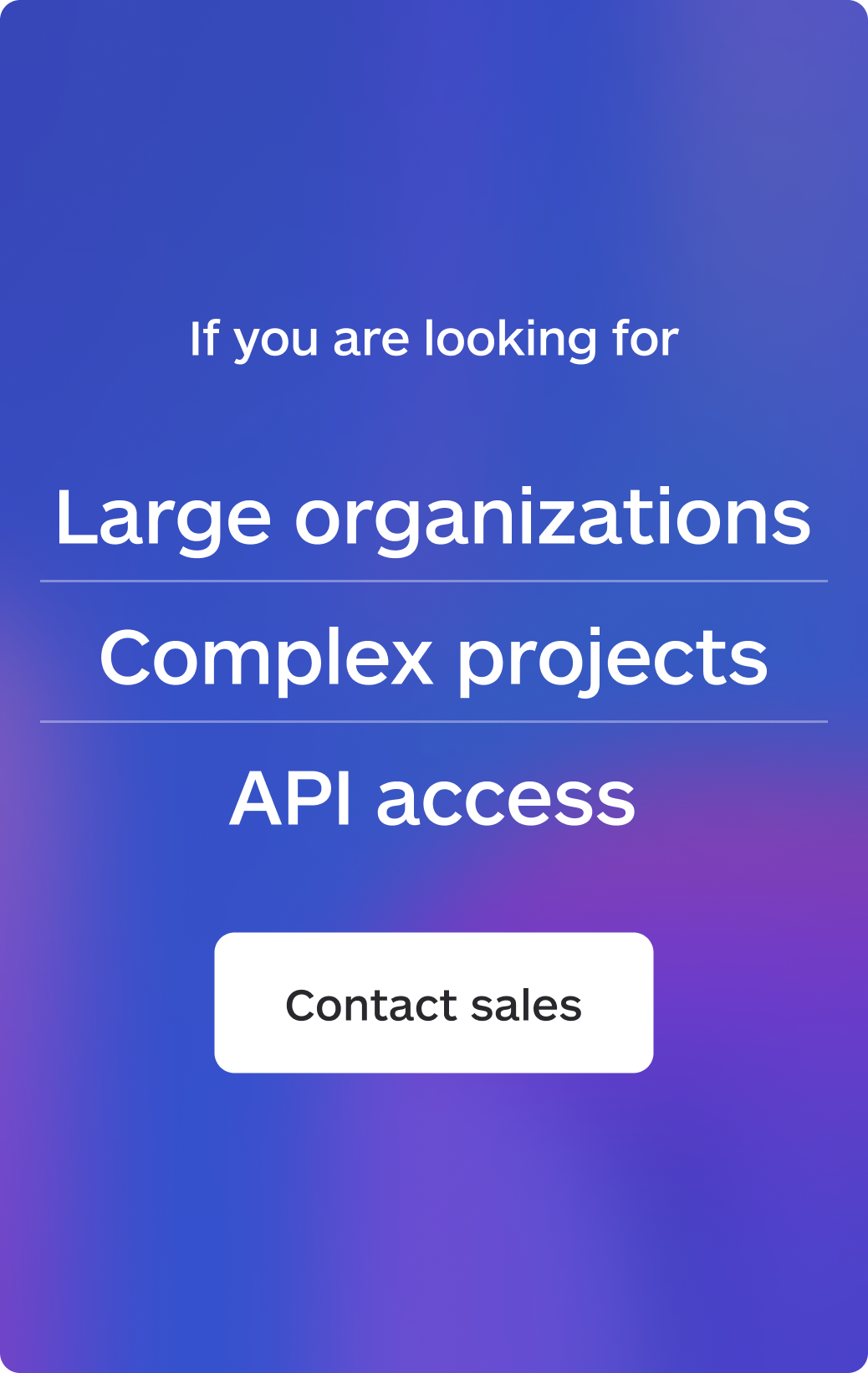Expanding a website to reach audiences in different languages is no longer a nice-to-have — it’s how global brands stay competitive. When users can search, read, and buy in their own language, engagement and trust grow exponentially. That’s why multilingual SEO has become a cornerstone of every serious international content strategy. But what exactly makes a website visible in different markets? What is multilingual SEO and why does it matter?
Multilingual SEO is the strategic process of optimizing your website content for multiple languages to improve visibility in search engines across diverse target markets. It goes far beyond simple translation, requiring a deep understanding of local search behaviors, cultural nuances, and technical implementation.
With a substantial percentage of search queries conducted in languages other than English, businesses without a multilingual SEO strategy are missing out on potential global traffic. Leading brands don’t just translate their content—they create localized experiences that resonate with local audiences and rank effectively in local search results.
This comprehensive guide explores seven expert strategies to make your content rank globally through effective multilingual SEO implementation.
TL;DR
|
Why it matters: multilingual SEO for global businesses
Search behavior is local. If your experience, keywords, and technical signals are not localized, algorithms default to the strongest single market and suppress your reach elsewhere. Getting multilingual SEO right compounds organic growth, lowers CAC by market, and improves conversion because people read, trust, and buy in their language.
Before diving into implementation strategies, let’s understand why multilingual SEO deserves a prominent place in your global marketing plan.
Expand your global reach
Multilingual SEO allows you to tap into new markets and target customers who prefer to browse and make purchases in their native language. By providing localized content, you demonstrate commitment to understanding and meeting their unique needs.
Create better user experiences
When users find content in their preferred language, bounce rates decrease and engagement increases. Multilingual SEO improves user experience by displaying relevant content, localized search results, and language-specific metadata, enhancing customer satisfaction and building brand loyalty.
Build search engine authority
Optimizing different language versions of your website signals to search engines that you’re a reliable source of information across multiple languages. This increases your chances of ranking higher in search results in different languages and markets.
Leverage cultural understanding
Multilingual SEO goes beyond translation by tailoring content to specific cultures and languages. This level of personalization demonstrates your understanding of cultural values and preferences, significantly enhancing customer trust and loyalty.
Increase brand visibility
By optimizing your website for different languages, you increase the likelihood of your content being shared across various social media platforms in multiple markets. This expands brand visibility, reaches wider audiences, and creates more opportunities for customer engagement and conversions.
How do I pick the right markets first?
-
Decide with data. Combine current traffic by country, revenue potential, logistics readiness, and support coverage.
-
Quick win filter. Prioritize markets with demand + content gap + feasible support.
-
Decision point: If you cannot support the language in CX or sales, defer the locale.
7 proven strategies for multilingual SEO success
Now, let’s explore the seven expert strategies that will help you implement an effective multilingual SEO approach and make your content rank globally.

Strategy 1: conduct thorough market research and target audience analysis
 The foundation of successful multilingual SEO is understanding which markets to target. This requires comprehensive research to determine:
The foundation of successful multilingual SEO is understanding which markets to target. This requires comprehensive research to determine:
- Market potential: which countries or regions have the most potential for your business expansion? Consider factors such as market demand, competition, and cultural fit.
- User behavior: people in different markets have different user habits. Research specific usage patterns in your target markets to inform your optimization strategy.
- Competitor landscape: analyze what your competitors are doing in target markets. This includes the topics they write about, how they optimize their websites for different user habits, their backlinks, and where those links originate.
Don’t just copy what competitors are doing—find ways to improve and differentiate your approach. If a competitor is targeting a specific keyword and ranking well, but their content isn’t comprehensive, create more detailed and valuable content on the same topic.
Strategy 2: perform comprehensive keyword research for each locale
 Keyword research in multilingual SEO isn’t as simple as translating your English keywords. Here’s how to approach it effectively:
Keyword research in multilingual SEO isn’t as simple as translating your English keywords. Here’s how to approach it effectively:
- Analyze existing traffic: if your website is already multilingual, use Google Analytics to identify which keywords are bringing visitors to your site from different regions.
- Localize your keywords: different markets may use different keywords for the same product or service. Using tools like Google Ads Keyword Planner and Google Trends, research how people in your target markets actually search.
- Consider search intent: work with native speakers or local SEO experts to understand the user intent behind search queries in each target language.
- Target local search engines: while Google dominates in many markets, others have their own popular search engines (like Baidu in China or Yahoo! Japan in Japan). Optimize for these platforms when relevant.
- Consider app store optimization: if you have a mobile app, don’t forget to optimize for app store search in each target market.
Remember that multilingual SEO means optimizing for each language individually. A direct translation of keywords often misses cultural context and local search patterns.
Strategy 3: choose the right URL structure for international sites
 Your website’s URL structure plays a vital role in multilingual SEO. It should be logical, user-friendly, and clearly indicate the language and region of each page. Here are the most common options:
Your website’s URL structure plays a vital role in multilingual SEO. It should be logical, user-friendly, and clearly indicate the language and region of each page. Here are the most common options:
- Country code top-level domains (ccTLDs): domains like example.es and example.fr send strong signals to search engines that these sites are for users in Spain and France. While this option provides the clearest geotargeting, it requires separate SEO efforts for each domain.
- Global top-level domains (gTLDs) with subdomains: using structures like de.example.com enables improved geographical targeting while maintaining some connection to your main domain. However, search engines sometimes treat subdomains as separate entities.
- gTLDs with subfolders: using example.com/es/ is typically the easiest structure to implement and maintain. It allows you to leverage the domain authority of your main site across all language versions.
- gTLDs with a combination of subdomains and subfolders: a structure like es.example.com/es-mx/ offers versatile site organization but adds complexity to implementation and maintenance.

Each approach has its advantages and limitations. Your choice should be based on your business needs, technical capabilities, and long-term international growth strategy.
Strategy 4: implement proper content localization (not just translation)
 Effective multilingual SEO requires proper content localization rather than simple translation. Here’s how to approach content localization strategically:
Effective multilingual SEO requires proper content localization rather than simple translation. Here’s how to approach content localization strategically:
- Create market-specific content: when possible, develop content that addresses topics specific to each target market, including local events, cultural differences, and region-specific challenges.
- Internationalize your source content: write original content that is easy to localize by using simple language, avoiding idioms and slang, and creating content that’s understandable even to non-native speakers.
- Adapt cultural elements: adjust product descriptions, images, examples, and messaging to resonate with the cultural preferences of each target audience.
- Use tiered localization approaches:
- For low-visibility content: machine translation may be sufficient
- For medium-visibility content: machine translation with human post-editing
- For high-visibility marketing content: human translation or transcreation by native speakers
- Transcreation vs. Translation: for marketing and promotional content, consider transcreation rather than direct translation. This involves recreating the message in the target language in a non-literal way that preserves the original intent and emotional impact while adapting it to the cultural context.
The relationship between translated content and SEO performance is critical to understand as you develop your strategy. High-quality translation that preserves intent while adapting to local contexts will generally perform better in search results than direct machine translations without proper adaptation.
Strategy 5: implement hreflang tags correctly
 Hreflang tags are HTML attributes that tell search engines about the language and regional targeting of your web pages. Proper implementation helps search engines display the correct version of your pages to users in different countries.
Hreflang tags are HTML attributes that tell search engines about the language and regional targeting of your web pages. Proper implementation helps search engines display the correct version of your pages to users in different countries.
There are three ways to implement hreflang tags:
HTML head: add hreflang annotations in the <head> section of each page
<link rel=”alternate” hreflang=”es” href=”https://example.com/es/page.html” />
<link rel=”alternate” hreflang=”de” href=”https://example.com/de/page.html” />
XML sitemap: include hreflang attributes in your XML sitemap
<loc>https://example.com/page.html</loc>
<xhtml:link rel=”alternate” hreflang=”en” href=”https://example.com/page.html” />
<xhtml:link rel=”alternate” hreflang=”es” href=”https://example.com/es/page.html” />
<xhtml:link rel=”alternate” hreflang=”de” href=”https://example.com/de/page.html” />
</url>
HTTP headers: use HTTP headers for non-HTML files (like PDFs)
Importantly, you must specify all language/regional versions of a page, including the current page itself. This allows search engines to understand that the pages are different versions of each other and helps them share ranking signals.
Strategy 6: build quality backlinks from local sources
 Backlinks remain one of the most influential ranking factors for search engines. For multilingual SEO success, you need to build backlinks from relevant websites in each target market. Here are effective approaches.
Backlinks remain one of the most influential ranking factors for search engines. For multilingual SEO success, you need to build backlinks from relevant websites in each target market. Here are effective approaches.
- Collaborate with local influencers: partner with bloggers, industry experts, and social media personalities in each target market.
- Create localized linkable assets: develop market-specific resources, tools, or research that local websites would want to link to.
- Participate in local communities: join forums, Q&A sites, and industry groups in each target market to establish your presence and expertise.
- Develop local partnerships: build relationships with complementary businesses or organizations in your target markets.
- Get featured in local publications: pitch guest posts or expert insights to popular blogs and news sites in each target language.

Building a strong backlink profile in each market requires significant effort, but the resulting improvement in search rankings makes it worthwhile.
Strategy 7: leverage technology for efficient multilingual SEO
 Managing multiple language versions of your website can be complex and time-consuming. The right technology can streamline this process and improve results. Having the right SEO tools for multilingual websites is essential for efficient implementation and monitoring of your global strategy. Here’s how technology can help.
Managing multiple language versions of your website can be complex and time-consuming. The right technology can streamline this process and improve results. Having the right SEO tools for multilingual websites is essential for efficient implementation and monitoring of your global strategy. Here’s how technology can help.
- Implement a translation management system (TMS): a robust TMS serves as a central hub for all your localization efforts, enabling efficient workflow management, quality control, and collaboration.
- Use translation memory: this technology stores previously translated content, ensuring consistency across your website while reducing translation costs and time.
- Leverage AI-powered machine translation: modern machine translation, when combined with human post-editing, can significantly accelerate the localization process.
- Integrate your content systems: connect your content management system (CMS), marketing automation platforms, and e-commerce platforms with your TMS for seamless content flow.
How Lara Translate powers multilingual SEO success
Managing content across multiple languages presents several significant challenges for global businesses. Translation consistency, terminology management, slow publishing cycles, and maintaining SEO performance across languages are common pain points that can derail even the most carefully planned international strategies. When deadlines are tight and content volumes are high, quality often suffers—ultimately affecting search visibility and user engagement.
When it comes to maintaining SEO performance across multiple languages, translation quality becomes a critical factor. Lara Translate uses advanced AI technology designed for professional translation needs, offering capabilities that can help address speed and accuracy challenges that traditional translation methods often face.
The platform supports a wide range of languages with notable efficiency, processing translations faster than many general-purpose language models. This speed advantage is particularly valuable for businesses managing large-scale multilingual content projects where time-to-market impacts competitive positioning.
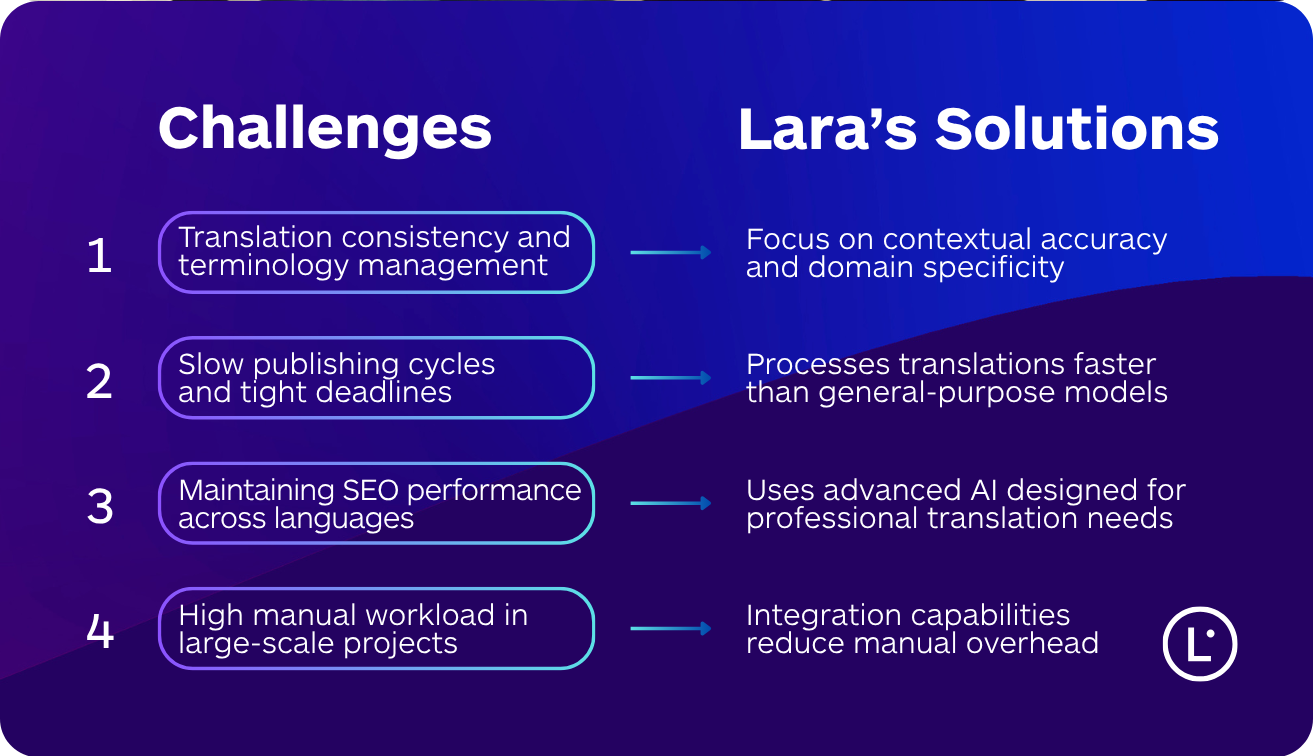
What makes Lara Translate helpful for multilingual SEO professionals is its focus on contextual accuracy and domain specificity. The system is designed to work with professionally reviewed documents, helping to ensure that technical terminology and industry-specific language are handled appropriately. For businesses expanding globally, this level of precision can help maintain brand voice and technical accuracy across all markets—essential elements for effective SEO performance.
Lara Translate offers integration capabilities that aim to help it work seamlessly with other business tools, potentially streamlining workflows for teams managing multilingual SEO campaigns. This can help reduce the manual overhead typically associated with large-scale translation projects while supporting the quality standards essential for effective international SEO.
By combining AI-powered translation capabilities with localization features, Lara Translate can help businesses scale their international SEO efforts without the traditional complexity and resource intensity of managing multiple language versions manually.
Common challenges in multilingual SEO (and how to overcome them)
Despite its benefits, multilingual SEO comes with several challenges. Here’s how to address the most common ones.
Managing content updates across multiple languages
Implement a centralized content management system with workflows that flag content for translation when updates occur. Prioritize updating high-traffic pages and cornerstone content first.
Handling cultural nuances and local preferences
Work with native speakers who understand both the language and cultural context of your target markets. Regular feedback from local teams or customers can help refine your approach.
Technical implementation complexity
Create a detailed technical SEO roadmap for your multilingual implementation, including URL structure, hreflang tags, and server configurations. Consider working with specialists experienced in international SEO.
Measuring performance across different markets
Set up market-specific analytics and reporting to track performance in each language/region. Define KPIs that account for different market maturity levels and competition intensity.
Measuring multilingual SEO success
To ensure your multilingual SEO strategy is effective, track these key metrics for each target market:
- Organic traffic by language/country: monitor growth in visits from each target market
- Keyword rankings in local search engines: track position changes for your target keywords
- Conversion rates by language/country: measure how effectively your localized content drives desired actions
- Engagement metrics: analyze time on site, pages per session, and bounce rate for each language version
- Backlink growth: monitor the acquisition of new backlinks from local websites
Use tools like Google Analytics, Google Search Console, and SEO platforms with international capabilities to gather and analyze this data.
Building a sustainable multilingual SEO strategy
Multilingual SEO is not a one-time project but an ongoing strategy that requires continuous refinement and adaptation. By implementing the seven strategies outlined in this guide—thorough market research, localized keyword research, appropriate URL structure, proper content localization, correct hreflang implementation, local backlink building, and leveraging technology—you can create a sustainable approach that drives long-term global visibility and growth.
Remember that success in multilingual SEO comes from balancing technical implementation with cultural awareness and local market understanding. It’s not just about making your website available in multiple languages but creating truly localized experiences that resonate with users in each target market.
With the right strategy and tools like Lara Translate, you can overcome the challenges of multilingual SEO and unlock the full potential of global search visibility for your business.
Are you ready to make your content rank globally? Start by identifying your priority markets and implementing these proven strategies one step at a time.
FAQs
How does multilingual SEO differ from international SEO?
Multilingual SEO focuses specifically on optimizing content for different languages, while international SEO is broader and includes targeting different countries or regions that might share the same language. For example, multilingual SEO would involve creating content in English, Spanish, and German, while international SEO might involve targeting the US, UK, and Australia (all English-speaking but with different regional preferences).
How long does it take to see results from multilingual SEO efforts?
Like any SEO strategy, multilingual SEO requires patience. Typically, you might start seeing initial improvements in visibility and traffic within 3-6 months, but establishing strong rankings across multiple languages usually takes 6-12 months of consistent effort. Factors like your site’s current authority, competition in target markets, and the quality of your localization all influence the timeline.
Is machine translation good enough for multilingual SEO?
While machine translation has improved dramatically, using it alone is generally not recommended for content that needs to rank well in search engines. Raw machine translation often lacks the nuance, cultural context, and keyword optimization needed for effective SEO. However, machine translation with human post-editing (MTPE) can be an efficient approach, especially for large volumes of content. High-visibility pages should always receive additional human attention to ensure they’re properly optimized for local search intent.
How do I prioritize which languages to target first?
Prioritize languages based on market potential and existing connections. Analyze where your current traffic comes from, research market size and competition, and consider practical factors like your ability to provide customer support in that language. Look for markets with the best combination of high potential and lower competition. Sometimes targeting a smaller language market with less competition can yield better initial results than going after highly competitive major language markets.
Can I use the same keywords across different languages?
No, effective multilingual SEO requires locale-specific keyword research. Direct translations of keywords often miss how people actually search in different languages and cultures. Even markets that share the same language (like Spain and Mexico for Spanish) can have different search terminology. Always conduct keyword research specifically for each target market, ideally working with native speakers who understand local search behaviors.
This article is about:
- Understanding multilingual SEO and its importance for global business growth
- Implementing proven strategies to optimize content for international search engines
- Overcoming common technical challenges in multilingual website implementation
- Leveraging translation technology to maintain SEO performance across languages
- Measuring success and continuously improving your multilingual SEO approach
 Have a valuable tool, resource, or insight that could enhance one of our articles? Submit your suggestion
Have a valuable tool, resource, or insight that could enhance one of our articles? Submit your suggestion
Useful articles
- Industry examples and localization strategies with Lara Translate
- How to optimize content for better machine translation
